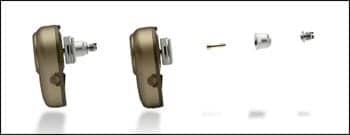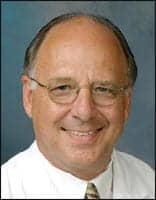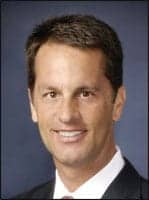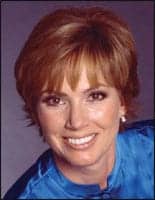In our January issue, we delve into tinnitus devices and treatments. Our roundup reflects the views of participants and is not intended to be a scientific survey.
We asked manufacturers/distributors:
- What are your best-selling products?
- Why are those items selling versus your other offerings?
- Tell us about changes you envision down the road.

|
| Garry Gordon, MS |
GARRY GORDON, MS
audiologist, CEO
EAR Inc, Boulder, Colo
There are two products that are doing very well. They’re homeopathic. One is called RingStop; the other is Premium Micronutrient. The validity of the product has been supported with research done by NASA, the Army, the Marines, and the Navy. We have seen a fair amount of success with the product when it’s used properly, but there isn’t anything that I’m aware of that’s 100% for treating [tinnitus]. The other devices we use that are unbelievably popular are basically devices to minimize the risk for advancing the problem of tinnitus, which are all the different ear protection systems on our Web site. The custom-fit earplugs are popular. Some of the electronic earplugs are extremely popular for those who are around impact sound. The interest in prevention is extremely high. There are clinical neuropathy type treatments that we’re hearing about—audiologists using them. I would assume we’re going to see more research on that. When we went through our training, many things—such as homeopathics—may not have been part of our training. It behooves us to investigate these situations to determine their validity.

|
| Roger Juneau |
ROGER JUNEAU
president
General Hearing Instruments Inc, New Orleans
Starting with a single canal open ear (COE), GHI has expanded to a diverse line of Tranquil sound generators and Combo hearing aid-sound generator devices. The Tranquil Simplicity has been successful due to cosmetics, ease of use, and cost/value. The ITE Combo devices offer quality amplification and sound generator circuitry in a compact, ear-worn design. The newly released Tranquil Sleeper offers 24/7 tinnitus relief with comfort, secure fit, and the patented, all-soft silicone body. GHI was recently awarded a follow-on grant by the University of Alabama, stemming from a completed study with the University of Maryland. The advanced study will involve a multimillion-dollar clinical trial, and will be a joint National Institutes of Health project with the Johns Hopkins School of Public Health. Craig Formby, PhD, of the University of Alabama, will be directing the Tinnitus Sound Therapy study. GHI has been contracted to develop the advanced, ear-worn instrumentation for that study. The Armed Services will be providing subjects from Naval, Marine, and Air Force personnel who suffer from debilitating tinnitus. The study is designed to verify the efficacy of tinnitus treatment. We believe the end result will lead to a new clinical protocol, and the emergence of the next generation of tinnitus and hyperacusis treatment devices. Combined with the encouragement to continue in tinnitus research and product development and the fortunate business location on the west side of New Orleans, the company successfully survived the disastrous aftermath of Hurricane Katrina.

|
| David W. Holmes, PhD |
DAVID W. HOLMES, PHD
president and CEO
Melmedtronics Inc, Hurst, Tex
Melmedtronics Inc has two new products: an ultrasonic device for the treatment of tinnitus, and a software program used in the evaluation of tinnitus. The Inhibitor is a small, handheld, ultrasonic device that is FDA-approved to be safe and effective in the treatment of tinnitus. A 1-minute treatment will provide immediate results. The patient can repeat treatments as needed. Clinical trials carried out over a 5-year period yielded these results: 50% of patients obtained complete relief, 25% received partial relief, and 25% reported no benefit. The results are temporary and vary from patient to patient. Results may last from minutes to days and, with some patients, even weeks. The Tinnitus Evaluation Program is software used in the evaluation and/or treatment of tinnitus. It takes a history; reviews medications, health conditions, and psychosocial measures; and quantifies tinnitus for frequency, intensity, and masking level. It quantifies the results of treatment, and generates a report and a Letter of Medical Necessity, when needed.

|
| Rick Giancola |
RICK GIANCOLA
CEO
Neuromonics Inc, Bethlehem, Pa
The Neuromonics Tinnitus Treatment is our primary product, and was developed with the intention of simultaneously addressing the auditory, attentional, and emotional processes underlying the condition. It involves use of a medical device, the Oasis, for daily, at-home administration of an acoustic treatment, together with a comprehensive education, counseling, and support program that typically involves six face-to-face appointments with the clinician over a 6-month period. A key component of the approach is the use of an individually prescribed acoustic stimulus, which provides a broad frequency stimulus to address the effects of auditory deprivation, while promoting relief and relaxation. This process reduces the engagement of the limbic and autonomic nervous systems, and applies the principles of systematic desensitization to address the attentional issues. This is complemented with a counseling and support program that is collaboratively tailored to the specific needs of each individual. By customizing the treatment in this way, its effectiveness, efficiency, and user acceptability are maximized. The Treatment is shown to be highly effective for suitable tinnitus cases, as demonstrated by 15 years of clinical studies and in general clinical practice. Neuromonics has recently received a grant from the government to evaluate our treatment with active duty personnel in the United States military, and will be initiating a large military clinical trial in 2010.

|
| Ralph T. Campagna |
RALPH T. CAMPAGNA
president
Amplisound, Danielson, Conn
Solace brand sound generators for tinnitus have been a success for many years. We have both programmable and nonprogrammable micro BTE RIC digital sound generators. Rainfall is a new product that features a sound generator and a mild high-frequency amplifier. The audiologist adjusts the hearing aid gain with a trimmer, while the user has full control over the level of the sound generator with the volume wheel. Solace sound generators are popular with many tinnitus professionals because they are specifically designed to meet the tinnitus patient’s needs. The devices are very small, cosmetically appealing, very comfortable, and easy to use. They have a large-size, user-volume wheel that is very easy to operate, it has a very gradual taper for easy adjustment, and it goes down to zero dB gain at minimum. All Solace devices use a patented receiver in the canal design—providing the best bandwidth and fidelity without insertion loss or occlusion effect problems. Rainfall is ideal for a majority of tinnitus patients, as tinnitus often accompanies mild high-frequency hearing loss. Tinnitus treatment will become more prevalent among audiology practices. Awareness and education, and training for audiologists, will increase due to efforts by organizations such as the Tinnitus Professionals Association. Helping to meet the needs of tinnitus sufferers will ultimately drive more patients to those offices that practice tinnitus. A majority of those tinnitus patients can benefit from wearing hearing aids, which will lead to an increase in hearing aid sales.
We’ve asked practitioners:
- What brand/type of tinnitus devices and treatments are you using?
- Have you tried other kinds?
- What do you like about your preferred product versus other kinds?

|
| Jennifer Derebery, MD, FACS |
JENNIFER DEREBERY, MD, FACS
associate, House Clinic and Ear Institute, Los Angeles, and clinical professor of otolaryngology, Keck School of Medicine, University of Southern California, Los Angeles
At House Clinic we offer Viennatone tinnitus maskers, hearing aids—often very effective in patients with hearing loss and tinnitus—and Neuromonics. We also have the addresses of a number of biofeedback therapists who will treat patients for tinnitus and who we refer to as well. We offer assistive devices as well, such as white noise and environmental sound-generating devices, or even air purifiers with HEPA filters, through our allergy department—kill two birds with one stone, etc. The physicians also counsel patients a great deal regarding the nature of tinnitus, correlate it with hearing loss, discuss the current thinking regarding central sources, etc. We have no issue with being frank with patients and suggesting when psychiatric or psychological counseling may add additional benefit to our specific recommendations. These sufferers can become severely depressed. I think the Neuromonics is the most effective in those patients who do not have hearing loss that would benefit from hearing aids, or who, despite hearing aids, are quite troubled. But, unfortunately, Neuromonics is not an inexpensive treatment. When we have referred patients for it and they have declined, it is the most commonly given reason. We have tried zinc, etc, through the years with little benefit. We frequently recommend high-dose niacin (Vitamin B3), and Lipoflavonoid, which will give some benefit. We do discuss Jastreboff Habituation, and have sent some audiologists to his program for training as well.
ELIZABETH GRAY, AUD
clinical audiologist
Jefferson Balance & Hearing Center, Philadelphia
GREGORY ARTZ, MD
assistant professor
Department of Otolaryngology—Head & Neck Surgery, Thomas Jefferson University Hospital, Philadelphia
Jefferson Balance and Hearing Center is using Neuromonics Tinnitus Treatment in conjunction with a multidisciplinary team to provide an effective therapeutic option for patients who suffer from tinnitus. Our patients are seen by neurotologists and audiologists, with support from psychiatry and psychology, as well as other professionals. As a tertiary medical center for the mid-Atlantic region, we see many patients who are coming for a second opinion. Because some of our patients travel from outside the immediate area, we needed an option that had statistically proven clinical utility for efficiency and effectiveness. Neuromonics clinical trial data helps us confidently provide therapy to our patients with fewer visits in a shorter period of time than is required for TRT protocol (tinnitus retraining therapy); 95% of Neuromonics patients have been found to have a 40% or greater reduction in their tinnitus disturbance as measured by the Tinnitus Reaction Questionnaire after 6 months of treatment. The clinical data also shows greater efficacy in a shorter period of time when using Neuromonics compared to TRT, maskers, or cognitive behavioral therapy. Because of the very good outcome data, we are actively prescribing Neuromonics to our patients who are greatly disturbed by tinnitus. We support cognitive behavioral therapy with referrals to supporting physicians and psychologists within the community. We do not prescribe maskers or provide TRT to our patient population.

|
| Gerald M. Haase, MD |
GERALD M. HAASE, MD
founder and chief medical officer
Premier Micronutrient Corp, Nashville, Tenn
Premier Micronutrient Corp has a patented, safe, and scientifically studied daily micronutrient product called Hearing Health. Designed to be a safe adjunct to current standard treatments, it is a rational biological strategy to address some of the same mechanisms of damage commonly involved in hearing disorders. This is not a cure, but these micronutrients are formulated based on over 30 years of strong antioxidant science, and may be expected to provide many patients with some symptomatic relief. The comprehensive formulation has been vigorously tested with the Department of Defense and the Navy for the Marines study. The data collected have a greater than 95% chance to be legitimate and less than a 5% chance to just be a coincidence actually proving benefits—for oxidative damage, inflammation, immune function, and biochemical abnormalities related to hearing loss, tinnitus, and balance disorders. Audiologists and ENTs continue to improve their understanding that the proper scientific micronutrients can be a perfect biological adjunct to the current standard technical devices used to treat hearing and balance disorders.
LORENZ M. FAEH
partner/ marketing
Tinnitus-Hilfe, Dismark GmbH, Maur, Switzerland
Our best-selling tinnitus device is our patented Soft Laser System TinniTool EarLaser. The Soft Laser cure is based on a self-treatment by the patients themselves, and is effective by biostimulating damaged cells in the inner ear against tinnitus and other inner ear disorders like Morbus Ménière—dizziness—acute hearing loss, and hearing distortion. The Soft Laser treatment is successful in more than 80% of tested individuals who were part of a double-blind study. There were more than 20,000 successful Soft Laser self-treatments with patients suffering from tinnitus and/or other inner ear diseases. Our down-the-road outlook/vision is to arrive at a diagnostic level by medicines to tell exactly what kind of tinnitus the aggrieved party suffers from, so health practitioners can recommend the most efficient cure to the sufferers. Also, the implementation of the power laser treatment against tinnitus by more doctors and audio specialists.

|
| Sol Marghzar, AuD |
SOL MARGHZAR, AUD
doctor of audiology, tinnitus consultant
The Hearing Doctor, Beverly Hills and Culver City, Calif
I use a variety of treatments for managing tinnitus. They include tinnitus retraining therapy (TRT), Neuromonics, tinnitus masking/partial masking, acoustic therapy, and cognitive behavioral therapy (CBT), or directive counseling. I use variety of devices for TRT. The most common—if the patient has normal or near-normal hearing—is the Tranquil, from General Hearing Instruments (GHI). If there is a significant hearing loss, I use a combination device. GHI has Jazz Duo or DigiK combination. Recently, the Widex Mind 440 has become my favorite choice. This device can be used as a combination device for masking/partial masking technique. For Neuromonics, there is only one choice, the Oasis processor. For patients with a low level of annoyance and disturbance, or those who have episodic tinnitus, we use a combination of acoustic therapies with various noises (downloaded in MP3 or iPods) and CBT counseling. One element that is included with all patients is one-on-one counseling. For some, it is directive counseling as postulated by the neurophysiologic model of the tinnitus, and for others, it is CBT counseling. The GHI Tranquil Noise generator is small, rather durable, and not very expensive; keeps the ear open; and has a decent frequency response. The Widex Mind 440 combination device is highly programmable, and has fantastic sound quality and the ability to be fit with a specific receiver that would reach up to 10 kHz. The Zen program has a noise module, which can be used by itself or in addition to the protracted music of the Zen. The Oasis is extremely programmable—with customization of the tinnitus signal according to the patient’s audiologic profile; it has the ability to monitor a patient’s compliance, and the ability to be used in bed; it is highly reliable—the recent Oasis version—and the new LCD warns the patient if there is a problem. I have tried the Amplisound combination device and Hansaton combination device.




